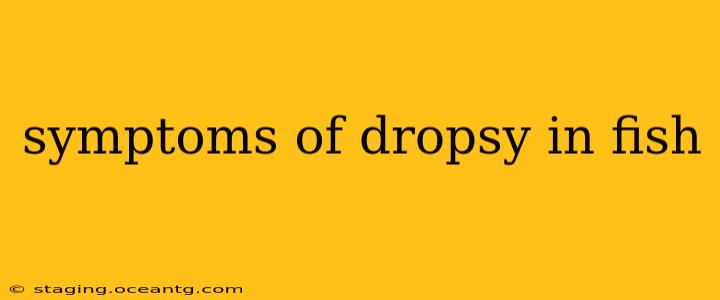Dropsy in fish is a devastating and often fatal disease characterized by fluid retention, causing the fish's abdomen to swell. While it's not a disease itself, but rather a symptom of an underlying issue, recognizing the symptoms early is crucial for potentially saving your fish. This comprehensive guide will delve into the various symptoms, causes, and treatment options for dropsy in fish.
What are the Signs of Dropsy in Fish?
The most prominent symptom of dropsy is a swollen abdomen, often described as a "pineconing" effect due to the raised scales. However, other symptoms often accompany this key indicator, providing a more complete picture of the fish's condition. These include:
- Pineconing: This is the classic sign of dropsy, where the scales protrude outwards, resembling the pattern of a pine cone. This is due to the fluid buildup under the scales.
- Lethargy and Loss of Appetite: Infected fish become lethargic, showing reduced activity and a loss of interest in food. They may remain motionless at the bottom of the tank.
- Redness and Swelling: Look for redness around the fins, gills, or the base of the tail. Swelling may also occur in other areas of the body.
- Protruding Eyes (Exophthalmia): Fluid buildup can affect the eyes, causing them to bulge outwards.
- Difficulty Swimming: As the disease progresses, the fish struggles to swim and may exhibit erratic movements.
- Frayed Fins: Damaged or frayed fins may also be present.
- Pale Gills: The fish's gills might appear paler than normal due to the systemic infection.
- Bloody Stool: In some cases, dropsy can be accompanied by bloody or stringy fecal matter.
- Clay-colored or White Stool: In other instances, the feces may be a sign of internal bacterial infection leading to dropsy.
What Causes Dropsy in Fish?
Dropsy isn't a single disease but rather a symptom of various underlying health problems. The most common causes include:
- Bacterial Infections: Many bacterial infections, such as Aeromonas hydrophila and Pseudomonas aeruginosa, can cause kidney failure, leading to fluid retention and dropsy.
- Kidney Failure: Damaged or failing kidneys are unable to effectively filter waste products, causing fluid buildup.
- Parasitic Infections: Certain parasites can also weaken the fish and lead to organ damage, resulting in dropsy.
- Viral Infections: While less common, viral infections can also cause similar symptoms.
- Poor Water Quality: Neglecting water changes and maintaining poor water parameters (high ammonia, nitrite, or nitrate levels) weakens the fish's immune system, making them susceptible to infection.
How is Dropsy Treated in Fish?
Unfortunately, dropsy has a high mortality rate. Once the symptoms are visible, the disease is often advanced, making treatment challenging. Effective treatment requires addressing the underlying cause, and prompt action is crucial.
While there's no guaranteed cure, treatment often focuses on:
- Improving Water Quality: Perform large water changes, using a water conditioner to remove harmful chemicals. Regular maintenance is critical.
- Antibiotics: Your veterinarian may prescribe antibiotics to combat bacterial infections.
- Antiparasitic Medications: If parasites are suspected, antiparasitic medications might be necessary.
Can Dropsy Be Prevented?
Prevention is always better than cure. By focusing on proper fishkeeping practices, you can significantly reduce the risk of dropsy:
- Quarantine New Fish: Always quarantine new fish for at least two weeks before introducing them to your main tank.
- Maintain Good Water Quality: Regularly test and maintain your water parameters (ammonia, nitrite, nitrate, pH). Perform regular water changes.
- Provide a Balanced Diet: A healthy diet boosts the fish's immune system.
- Avoid Overstocking: Overcrowding increases stress and makes fish more vulnerable to disease.
Is Dropsy Contagious?
Yes, the underlying infections that cause dropsy can be contagious to other fish in the tank. Therefore, prompt isolation of the affected fish is important to prevent the spread of the disease.
What is the Prognosis for Fish with Dropsy?
The prognosis for fish with dropsy is unfortunately poor. While some cases respond to treatment, many fish succumb to the disease. Early detection and prompt treatment offer the best chance of survival.
How Quickly Does Dropsy Progress in Fish?
The rate of progression varies depending on the severity of the underlying infection and the fish's overall health. In some cases, symptoms may progress rapidly over a few days, while in others, the progression may be slower.
This information is for educational purposes only. Always consult with a qualified veterinarian or experienced aquarist for diagnosis and treatment of fish diseases. Early detection and intervention are key to improving the chances of a positive outcome.
